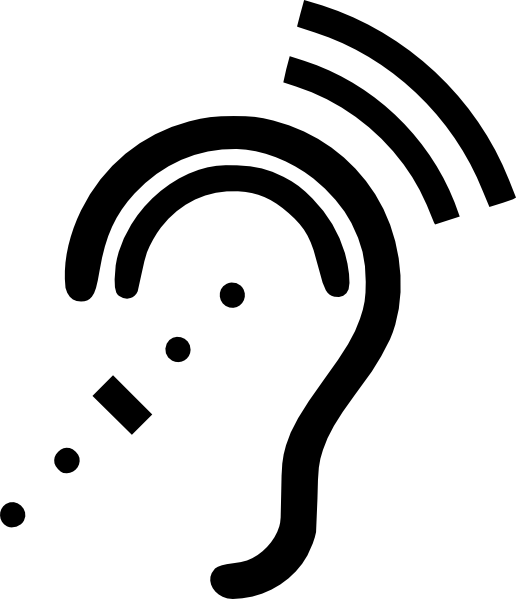
Windshield wipers silently swiped back and forth. I drove past rainy Illinois farm fields toward the audiologist’s office. After too many unheard whispers and missed cries for help from my sons, it was time. Thirty years old, for the first time in my life, I decided to purchase hearing aids.
The audiologists office walls featured posters with smiling gray-haired senior citizens. Bill Clinton had just started wearing hearing aids. I had babies and toddlers at home and resisted the temptation to feel old as the President of the United States. I felt too young for hearing aids but knew the inevitable had come to call.
Over time, my husband learned to compensate for my loss. He started to use his “yelling voice” more frequently in order to be heard. Over time. even the kindest yelling starts to feel subconsciously like angry emotional weather. An unspoken tension hovered over our house. Our four sons (ages 9, 7, 3, and 1) rattled around happily in the loud old Craftsman bungalow full of bouncing sound waves on cracked plaster walls and bare wood floors. It was nearly impossible to sift and find their quiet ideas and excited stories inside the noise.
The audiologist looked like a defeated version of Steve Jobs stuck in a boring day-job. Paper piles and random plastic ear molds lined either side of a narrow desktop path between his side and mine. He slid an instruction pamphlet toward me and polished his wire glasses on the bottom of his shirt. He carefully removed my new hearing aids from a little felt-lined black box. Batteries clicked into place, the aids started to squeal in his cupped hands. He forced a tired half-smile, “Ready to take them for a drive?” Dr. Jobs was so matter-of-fact, I got the impression my first test drive with hearing aids would be an easy flick of a light switch; off to on, dark to light. I was wrong. After the long slow muting of a million tiny sounds, the sudden ability to hear is not at all like a simple light switch. Re-amplification is more like an auditory tsunami.
On the drive home, I found myself swimming in a flood of new sounds. Rain pinged and plucked on the windows. The turn-signal clicked and the windshield wipers swooshed. My coat made a loud crackling rustle every time my arm brushed my side. The buckle on my leather shoe squeaked. I got out of the car and heard the crystal blue notes of a songbird in the redbud tree. Dumbfounded by the long-forgotten ordinary miracle, I felt a sudden compulsive need to tell someone, anyone, “Birds fly AND make music!”
Inside the house, wonder quickly turned to bewilderment. Our wood floors creaked like loud creeping skeletons. Plaster walls echoed the bang of toys and thunder of feet. Dropped pans exploded like gun shots. The wall clock ticked relentless like a watery drip, drip, drip on my brain every second, every minute, every hour. I became irritable, snappy, short-fused in the relearning.
The exhausting flood of sound is not uncommon with new hearing. In Pilgrim at Tinker Creek, author Annie Dillard describes a similar sense of overwhelm among blind people who surgically regain a missing sense. “The mental effort involved … proves overwhelming for many patients. It oppresses them to realize, if they ever do at all, the tremendous size of the world, which they had previously conceived of as something touchingly manageable.” A reamplified sense requires some challenging recalibration.
After a first fitting for hearing aids, two important things need to happen. Mechanically, a few follow-up appointments are necessary to tweak the instrument levels and eliminate extreme highs or lows. But more importantly, the brain has to re-learn how to hear and how to listen. Mental adjustment takes time.
In the first days of hearing, a whole host of sounds must be catalogued as noise. For example, at first the hiss and hum of a fluorescent ceiling light warrants attention. It’s a new sound, after all but the light bulb is not as important as the little son who is pulling on my sweat pants quietly asking for me to pick him up and hold him. In the larger scheme of listening, the relentlessly ticking clock doesn’t warrant my attention; neither does the squeaking shoe, or the regular click of the furnace. Instead, children’s whispers and door bells gain priority. Over time, an entire raging ocean of small noises is catalogued as background sound and a wide pool of sameness begins to differentiate. With the repetition of identification, noises mute and sounds with meaning amplify.
Ultimately, a brain will find patterns and follow where attention goes. In the practice of learning to listen, larger questions started to emerge about the stuff of my listening. Hearing is a mechanical practice. But listening is a choice of attention. Which made me wonder about larger life questions., “What do I listen to … what usually gets my attention?”
Some days, when the noise of the world gets especially loud, I take out my hearing aids. I sit in the muted humms and listen to my heartbeat. I feel my lungs inflate with each breath. I remember that I am a spiritual being in a physical body. And something shifts. In the quiet I remember the God of the Universe who restores my sanity. I try to listen for what matters. And maybe that’s my biggest lesson from that first pair of hearing aids.
In a world full of clamoring sounds, we all have to learn to sift through noise in order to listen for matters most.
Edited and reprinted from an old post — 5/2014
